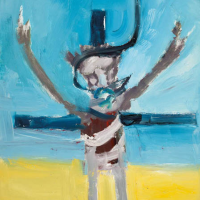53. SIDNEY NOLAN Hanged Crucifix

In 1980 the Rudy Komon Gallery in Sydney exhibited twenty- three Kelly paintings which were executed by Sidney Nolan in 1979 for an exhibition that was to coincide with the centenary of Ned Kellys death in 1880. The series, of which the present work formed a part, was painted at Ruthland, the home of Mary Boyd in southern Wales, not long after her marriage to Nolan in 1978.
Nolan produced most of his Kelly suites between 1945 and 1980. Whilst each Kelly series shows evidence of distinctly different styles, Nolan built around the figure of Kelly a narrative in which he explored ideas of violence, love, folly, authority, and personal responsibility. For Nolan, Kelly was an intensely compelling figure who, like the artist, came from working class Irish stock. Nolans interest in Kelly stretched back to his boyhood, where he was entranced by yarns about the bushranger told by his grandfather, a member of the police force deployed to hunt for the Kelly Gang.
For the greatest part of the seventies Nolans Kelly imagery noticeably diminished. However, the Kelly works that were produced, especially towards the end of the decade, could be considered some of the most challenging and psychologically charged pieces of his oeuvre. Interspersed with Nolans more obvious representations of the bushranger and the various characters from the Kelly story, are references born of the artists fascination with the tale of Oedipus, together with his interest in Christian iconography.
Nolan had produced a series of heads and crucifixions as early as 1955, painting variations on the theme of a primitive crucifix in a landscape inspired during his travels around Italy in 1953-54. Kenneth Clark noted The European heads, paintings of Italian crucifixes against a background of Italian hill-side towns, and Christ images, which follow, reflect a side of Nolans imagination that is concerned with the outer props and manifestations of religion as much as a concern to make a head of Christ which might tactfully and naturally embody more generalised characteristics. The references to Kelly and the convict are very apparent.1
Some twenty-four years later Nolan revisited the crucifix theme. In Hanged Crucifix we are presented with a bushranger-type character portrayed as Christ crucified, his fate all the more confronting by the presence of the hangmans noose coiling up and beyond the edge of the canvas. The vivid symbolism and complex psychological layering of this work highlights Nolans dark and romantic vision.
Hanged Crucifix is an important member of a series of disarmingly immediate paintings that championed the mythic layers of Australias past and created a series of images uniquely tied to the identity of Ned Kelly.
Footnotes
1. Clark, K., MacInnes, C., and Robertson, B., Sidney Nolan, Thames and Hudson, London, 1962, p.140